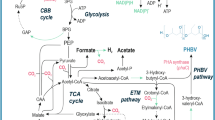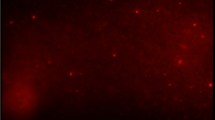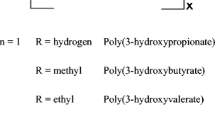Abstract
In recent years industrial interest has been focussed on the evaluation of poly(3-hydroxyalkanoates) (PHA) as potentially biodegradable plastics for a wide range of technical applications. Studies have been carried out in order to optimize growth and culture conditions for the intracellular formation of PHA in the phototrophic, purple, non-sulfur bacterium Rhodobacter sphaeroides. Its potential to produce polyesters other than poly(3-hydroxybutyrate) (PHB) was investigated. On an industrial scale, the use of photosynthetic bacteria could harness sunlight as an energy source for the production of these materials. R. sphaeroides was grown anaerobically in the light on different carbon sources. Under nitrogenlimiting conditions a PHA content of up to 60 to 70% of the cellular dry weight was detected. In all of the cases studied, the storage polymer contained approximately 98 mol% of 3-hydroxybutyrate (HB) and 2 mol% 3-hydroxyvalerate (HV) monomer units. Decreasing light intensities did not stimulate PHA formation. Compared to Rhodospirillum rubrum (another member of the family of Rhodospirillaceae), R. sphaeroides showed a limited flexibility in its ability to form PHA with varying monomer unit compositions.
Similar content being viewed by others
References
Brandl H, Gross RA, Lenz RW, Fuller RC (1988) Pseudomonas oleovorans as a source of poly(β-hydroxyalkanoates) for potential applications as biodegradable polyesters. Appl Environ Microbiol 54: 1977–1982
Brandl H, Gross RA, Lenz RW, Fuller RC (1989) Ability of the phototrophic bacterium Rhodospirillum rubrum to produce various poly(β-hydroxyalkanoates): potential sources for biodegradable polyesters. Int J Biol Macromol 11: 49–55
Brandl H, Gross RA, Lenz RW, Fuller RC (1990) Plastics from bacteria and for bacteria: Poly(β-hydroxyalkanoates) as natural, biocompatible, and biodegradable polyesters. In: Ghose TK, Fiechter A (eds) Advances in biochemical engineering/biotechnology, vol 41. Springer, Berlin Heidelberg New York, pp 77–93
Byrom D (1987) Polymer synthesis by microorganisms: technology and economics. TIBTECH 5: 246–250
Capon RJ, Dunlop RW, Ghisalberti EL, Jefferies PJ (1983) Poly-3-hydroxyalkanoates from marine and freshwater cyanobacteria. Phytochemistry 22: 1181–1184
Dawes EA (1986) Microbial energetics. Blackie. Glasgow London
Dawes EA, Senior PJ (1983) The role and regulation of energy reserve polymers in micro-organisms. Adv Microb Physiol 10: 135–266
Doudoroff M, Stanier RY (1959) Role of poly-β-hydroxybutyric acid in the assimilation of organic carbon by bacteria. Nature 183: 1440–1442
Fritzsche K, Lenz RW, Fuller RC (1990) Production of unsaturated polyesters by Pseudomonas oleovorans. Int J Biol Macromol 12: 85–91
Göbel F (1978) quantum efficiencies of growth. In: Clayton RK, Sistrom WR (eds) The photosynthetic bacteria. Plenum Press, New York, pp 907–925
Gross RA, DeMello C, Lenz RW, Brandl H, Fuller RC (1989a) The biosynthesis and characterization of poly(β-hydroxyal-kanoates) produced by Pseudomonas oleovorans. Macromolecules 22: 1106–1115
Gross RA, Brandl H, Ulmer HW, Tshudy DJ, Uden PC, Fuller RC, Lenz RW (1989b) The biosynthesis and characterization of new poly(β-hydroxyalkanoates). Polym Prepr 30 (1): 492–493
Holmes PA (1985) Applications of PHB — a microbioally produced biodegradable thermoplastic Phys Technol 16: 32–36
Merrick JM (1978) Metabolism of reserve materials. In: Clayton RK, Sistrom WR (eds) The photosynthetic bacteria. Plenum Press, New York, pp 199–219
Shively JM (1974) Inclusion bodies of prokaryotes. Annu Rev Microbiol 28: 167–187
Uttley N (1986) Polyhydroxybutyrate — a commercial challenge. Appl Biotechnol, Proc Biotech '86, vol 1, pp 171–177
Zürrer H, Bachofen R (1982) Aspects of growth and hydrogen production of the photosynthetic bacterium Rhodospirillum rubrum in continuous culture. Biomass 2: 165–174
Author information
Authors and Affiliations
Rights and permissions
About this article
Cite this article
Brandl, H., Gross, R.A., Lenz, R.W. et al. The accumulation of poly(3-hydroxyalkanoates) in Rhodobacter sphaeroides . Arch. Microbiol. 155, 337–340 (1991). https://doi.org/10.1007/BF00243452
Received:
Accepted:
Issue Date:
DOI: https://doi.org/10.1007/BF00243452




